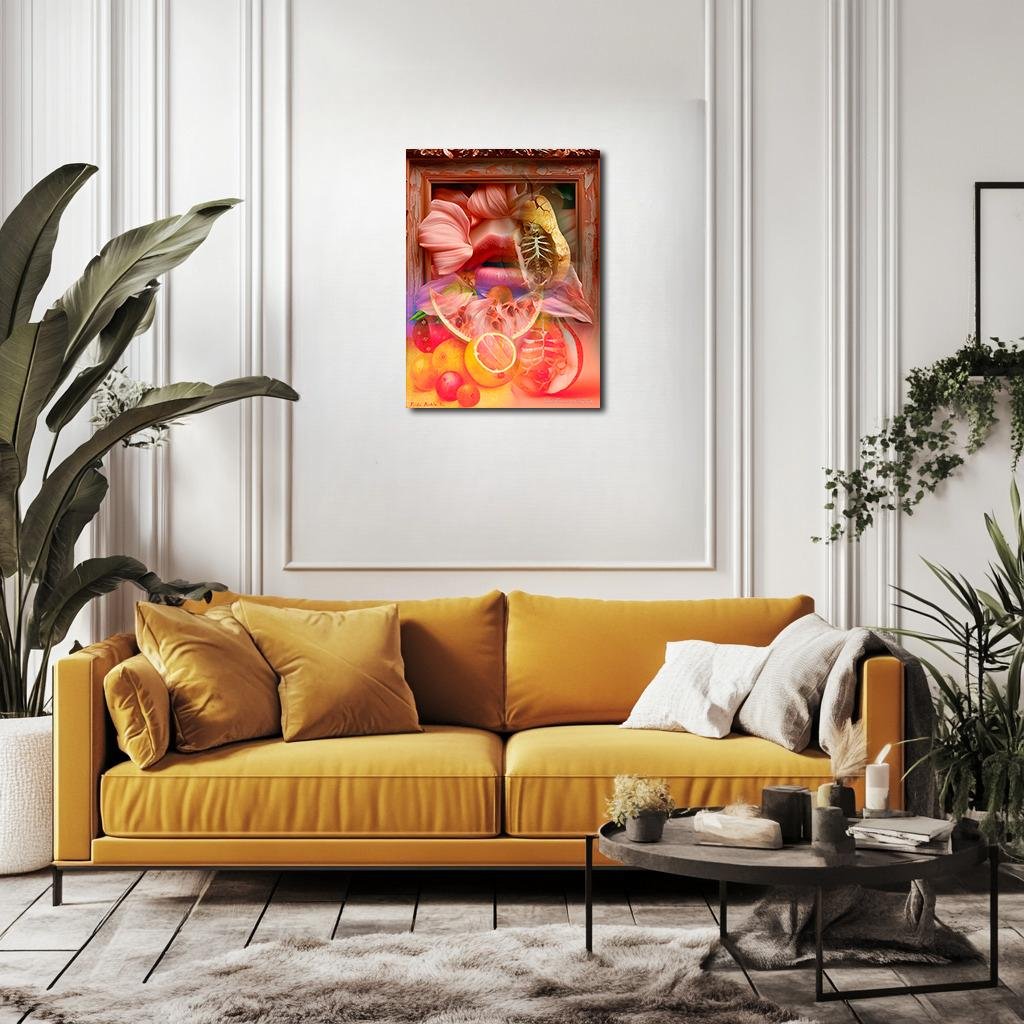The Flesh of Memory: Frida’s Still Life Reborn
The Flesh of Memory reimagines Frida Kahlo’s Still Life with Fruit and Parakeet as a lush and intimate anatomy of longing and mortality. Through rose-petal lips, skeletal pears, and pomegranates split like hearts, the painting becomes a sacred fusion of body and offering. With blood-red, citrus gold, velvet blush, and bone-white hues, the still life dissolves into a sensual meditation on what we consume and what we carry—reminding us that every bite of sweetness bears the echo of time, decay, and desire.
Please see Below for Details…
Hotline Order:
Mon - Fri: 07AM - 06PM
404-872-4663
This conceptual reimagining of Frida Kahlo’s Still Life with Fruit and Parakeet unfolds the delicate sensuality and veiled violence of her late compositions into a surreal meditation on taste, vulnerability, and the erotic intimacy between body and offering. Titled The Flesh of Memory , the piece blurs the border between skin and pulp, fruit and organ, sensation and remembrance. No longer simply an arrangement of objects, this still life becomes a reverie of longing—sweet, exposed, and irrevocably human.
At its core lies a framed window, ornate and aged, holding within it a close-up of lips—full, slightly parted, flushed with suggestion and silence. These lips, unlike the passive presence of traditional still life, are central, beckoning. Around them swirl soft folds of rose petals, or perhaps silk or flesh, enveloping the mouth in a blooming intimacy. They appear both floral and corporeal, echoing the simultaneous fragility and desire that so often permeated Kahlo’s work.
Emerging beside this sensual center is the split form of a pear, but it is no ordinary fruit—it reveals a small skeletal figure curled within, ribs and spine exposed, a fetal echo trapped inside ripened skin. The pear becomes a tomb and a womb at once, the flesh of nourishment turned to a symbol of mortality. This is the heart of Frida’s paradox: that life is not separate from death, and that beauty carries its own expiration date.
Scattered across the lower half of the image is an explosion of citrus—halved grapefruits, peeled oranges, blood-red pomegranates, and sun-kissed lemons. Their slices and pulps are rendered in hyperrealistic detail, glistening, wet, their textures both luscious and surgical. But here, each fruit is not simply food—it is a mirror. Sliced open like torsos, their segments recall ribs, their seeds like bone marrow, their juices like plasma. This is not merely nourishment; it is embodiment, dissection, and offering all at once.
Behind the fruit, another ribcage—transparent, anatomical, softly glowing—floats in ghostly reflection, suggesting that what we consume, we become. The organs of a body echo the segments of fruit; the still life becomes not a table, but a torso.
The color palette of The Flesh of Memory is saturated with sensual density and symbolic layering. The fruits are alive with reds that veer into burgundy, blood orange, and coral-pink—tones that evoke passion, life force, and internal blooming. Their contrast is held by the citrus yellows—acidic gold, lemon chiffon, and ripe honey—colors that carry both vitality and warning, the sweetness before the sting.
The lips and petals are composed in shades of blush rose, muted mauve, and porcelain peach. These colors soften the gaze but do not diminish its power; they invite rather than impose, asking the viewer to look closer, to taste with their eyes. The skeletal elements, by contrast, are rendered in pale ivory, bone white, and translucent gray—the hues of what remains after ripeness has passed.
The background bleeds in gradients of magenta, sunset orange, and violet haze, surrounding the image with warmth that feels both sensual and feverish. It’s the warmth of late summer, of memory, of bodies pressed close and then pulled apart.
When I created The Flesh of Memory , I sought to uncover the beating intimacy hidden inside Frida Kahlo’s quietest works. Her still lifes are often overlooked—yet they are profound meditations on what remains, what ripens, what is consumed, and what must be let go. In this reimagining, the fruit is no longer passive. It is sensuous, anatomical, sacred. The parakeet of the original painting has vanished in form but is echoed in the curves of the petals and the whisper of pink against the frame—its voice transformed into mood, its chirp into perfume.
The composition draws the viewer downward, from the open lips to the skeletal pear to the fruit’s intricate interiors, and finally rests on the orange slice inscribed with seeds like a circular wound. The movement mimics digestion, or memory: taking in, breaking open, absorbing, remembering.
In this vision, Frida Kahlo is not the painter beside the table—she is the table, the fruit, the whisper of sugar and bone within each slice. She reminds us that stillness is never truly still—that even in painted death, there is a pulse, a sweetness, a rot that breathes.
Add your review
Your email address will not be published. Required fields are marked *
Please login to write review!
Looks like there are no reviews yet.








